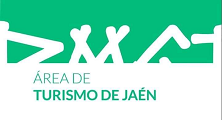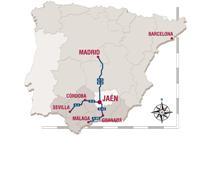- es
- en

| Early Ages | 8th to 15th century |
IBERIAN CULTUREAccording to archaeology, Jaén’s origins can be traced back to the Chalcolithic period. We can highlight the archaeological sites of Marroquies Bajos, (nowadays the Bulevard) the biggest and most populous of European Copper Age and the Iberian oppidum in Puente Tablas. Both sites were located and developed at the outskirts of the city. In contrast, the first settlements that gave origin to what we call today Jaen’s urban core came from the concentration of population around Saint Catalina’s hill slope in Iberian period (800/700 B.C.) The hill of the castle is a great viewpoint in which you can admire the whole city and part of the provinces territories, from Sierra Mágina to the wide Guadalquivir Valley, the historic location of plenty of cultures over centuries. The historical evolution of those settlements gave origin to the Roman town of Aurgi.
|
BORDER TOWNDuring the Arabic domination (8th and 13th centuries) we can find the basis of Yayyan urban development: mosques, baths and palaces were built around Magdalena’s quarter, with people depending on the good use of water systems especially Magdalena’s torrent. The city was also fortified and a fortress was built on the top of the hill. After some sieges, Jaén was conquered by Ferdinand III “The Saint” in 1246, after a deal with King Alhamar. Jaén played an important role in Granada’s conquest, so King Enrique II of Castile granted the city the title of “The Noble and Loyal Town of Jaén, Guardian and Defender of Castile Kingdoms”. He also gave the city a council and a town-hall that were developed in the 15th century with the arrival of the Condestable of Castile Miguel Lucas of Iranzo, King Enrique IV favourite, in Jaén. A major urban reform took place under his government, streets and squares were enlarged and he improved the hygiene, health and safety conditions and reinforced the fortress.
|
| 15th to 19th Century | 21st Century |
RENAISSANCE TOWNAfter Granada was conquered and America was discovered, Jaén was a very important Castilian city, with an economy based on cereal harvest, leather tanning activities and a craft sector. We can find Jaen’s artistic splendour of the period in Andres de Vandelvira Renaissance cathedral. In the 17th century the plagues, the hunger, the armed conflicts and nobility fights lead to a decrease of the population and the poverty of the city. Jaén experienced revitalization in its battered economy with the re-emergence of agriculture and the development of the artisan associations. The Independence war coincided with economic stagnation and social unrest. The capital of the city had an important role in Bailen’s battle. In the 19th century there were confrontations between Absolutist and Liberal troops during the so-called Liberal Triennium (1820-1823). At the same time, Jaen started to grow and expand its urbanism, and finally in 1833 it was declared the province’s capital. |
MODERN CITYIn the 20th century we can find the rise of Socialism due to the agrarian struggles. The proclamation of the Republic brought a period of prosperity to the capital. Years after, social confrontations lead to the civil war in 1936. In the early stages of the war, Jaén was loyal to the republican troops until the city fell under Franco’s Armies control. In the post-war period the city had several critical moments until the middle of the sixties when there were improvements in the economy as well as great urban expansion. The advent of democracy brought hope to the city coinciding with great economic development in the capital. Municipal, regional and national government, as well as European funds, reinforced the business network of the capital, promoted new public works, enlarged the city and made it a modern and entrepreneurial capital. In 1993 Jaén’s University was created, leading the city into an optimistic 21st century. |














